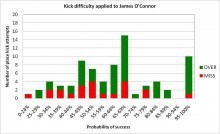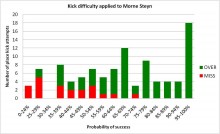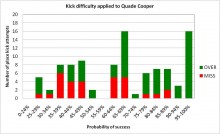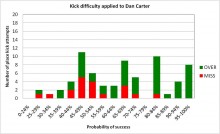Despite the media lauding a goal kicker’s stats, G&GR readers often remark that doesn’t take into account difficulty. It’s a well repeated comment that hasn’t been resolved due to a lack of data, until now.
 I too have been frustrated, so I wrote an article applying difficulty to the comparison of two place kickers. It showed that Arron Cruden 80% kicking success record was due to 1/3rd of his Super15 attempts being in front of the posts. Dan Carter whose kicking average he was being compared to had only had 12% of his attempts out in front. G&GR spotted my piece and thought it might be time to step up to the big time and apply difficulty to the likely Tri-Nations kickers here (and I threw in Cooper for the hell of it).
I too have been frustrated, so I wrote an article applying difficulty to the comparison of two place kickers. It showed that Arron Cruden 80% kicking success record was due to 1/3rd of his Super15 attempts being in front of the posts. Dan Carter whose kicking average he was being compared to had only had 12% of his attempts out in front. G&GR spotted my piece and thought it might be time to step up to the big time and apply difficulty to the likely Tri-Nations kickers here (and I threw in Cooper for the hell of it).
One of the great things about G&GR over other outlets is that they let you put up graphs. There are other things too, like not having to dumb it down. To help out with the graphs I’ll talk a little bit about each kicker then draw some comparisons. I’ll also pop back into the forum to answer any questions that won’t take a week or two to work out.
I can undertake all this as I have a database of place kicks from the last ten years from a variety of professional rugby union competitions. From this, due to the volume of kicks taken and some very smart algorithms, a probability of success (POS) of a kick can be calculated of any kick in similar circumstances.
For example if 73% of all the kicks in similar circumstances are successful, then you can expect the kick to go over 73% of the time. A kicker in that situation is given a POS of 73% as he is lining it up. I use this number because it’s what the computer spat out for Cruden’s last kick to win against the Reds. I didn’t believe the POS and asked it to run it twice more. Note to self: always believe the computer.
The database is now so big that the numbers don’t move more than a decimal point over a season except when the kicker is 65 metres out. What I have developed is similar to what the franchises have, except they don’t share it. It is used to understand their’s and the opposition’s kickers. Just so we are clear I code every game, mostly live including POS, so I haven’t just borrowed the data from some other website.
Just for the record, at the end of the Super15 round-robin, not including POS, James O’Connor’s (JOC) kicking success was 71% (54 from 76), Quade Cooper 69% (68/98) Morne Steyn 79% (79/100) and Carter’s 72% (50 from 69). I only am using the round-robin kicks as it is a more consistent approach across the kickers.

Throughout the season I observed that JO’C was asked to take more and more kicks that had a low POS. The data backs this up. JOC kicks on his graph are more towards the low POS end. In fact three-quarters (75%) of his attempts had a POS of 69% or lower.
Applying difficulty shows that JO’C was getting asked to take harder kicks and the fact that there were few Western Force tries added to his lack of opportunity to take high POS kicks. This pushes his kicking success down and makes him look ordinary to the media when the reality is he had a big ask.

Steyn is a typical of what you would expect, or want, from a kicker. He gets all the high POS kicks and his first miss, moving back from the posts, was in the 70-74% POS range. As the POS lowers Steyn starts to miss more but you have to go back to POS range of 25-29% before he is misses more than he is getting. Either way he is a reliable kicker.
Cooper is more varied, and at times I had to go back and re-check his kicks as there were ones he was getting with a low POS and missing others he should have got (note – none needed to be changed).

A good example is his kicks in the 25-29% POS, where he got 4 out of his 5 attempts. That is impressive. JOC also knocked over his two attempts from there as well, whereas Steyn was 2/7 and Carter 1/2.
So in the last minute of the game with a 25-29% POS penalty kick lined up, you would back JOC and Cooper for it. But if it happens and you do back them don’t blame me if they miss, there is a reason it has that POS. Post script: Cooper’s 1st kick in the Super15 final was in this 25-29% POS and he got it.

Excluding JOC, all three kickers had 41-42% of their attempts in the 70-100% POS range. This seemed just weird initially but upon reflection the distribution is what you would expect in attempts over a season. This highlights further that JOC was asked to take kicks he should not have. If his franchise didn’t know this maybe his new one will.
Since Cooper, Carter and Steyn each had 41-42% of their attempts in the 70-100% POS, it provides a useful comparison. In the 70-100% POS range you would expect kickers of the calibre we are examining to get most of them, and they do. Carter got 93% (26/28) of his attempts at this range, Steyn was the best getting 98% (40/41) of his attempts and Cooper 90% (36/40).
Things even up in regard to similar proportion of attempts around the 0-54% POS. Around 38% of JOC and Carter’s kicks, 35% of Cooper’s attempts and 34% of Steyn’s were in this 0-54% POS range. However their success is different. In this POS range, JOC is 55% successful (16/29), Cooper 53% (18/34), Carter 50% (13/26) and surprisingly Steyn is 43% (16/34).
Other things that stood out for me were in what I call the 50/50 kicks. These are in the 45-54% POS range. In here Cooper is in his element being 64% successful (7/11) from his attempts. In comparison Steyn’s success is 58% (7/12), JOC 56% (7/12) and Carter 47% (8/17).
So who would I want running out in my team to be taking the kicks? I’ll leave that for the you to sort out. You now have data points you never have had before, so it is up to you.

